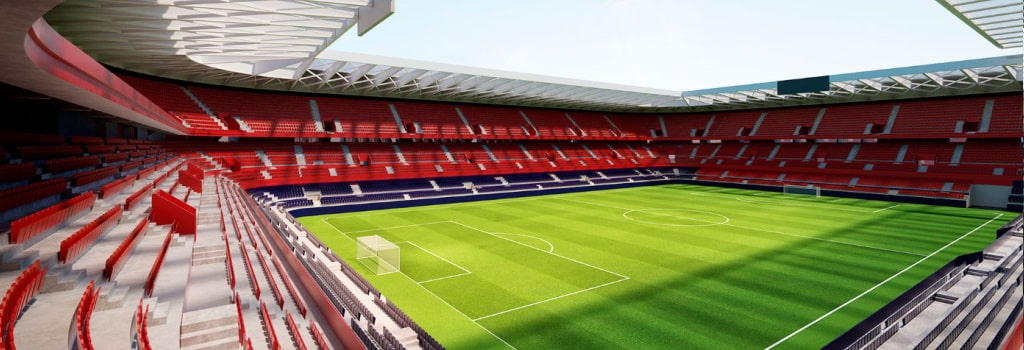

Not every club or city can afford the vast expense of building a completely new stadium, despite the fact some Spanish clubs have moved homes over the last decade. Instead, reforming existing venues is the way to go. This can sometimes be a less costly option, whilst also affording the option to spread out the work over different phases.
Football fans can also be deeply passionate about their traditional home stadiums, which means that moving can be met with considerable rejection, unless there is absolutely no alternative. When clubs give their home venue a significant facelift, even though it can completely change the aspect of a stadium, it remains the original historic home.
Four clubs in Spain's La Liga have taken this approach recently, choosing to stay put and reform, rather than move elsewhere. Let's take a look at how they're getting on.
Despite being one of the most famous football stadiums in the world, even the most ardent fans would admit the Real Madrid Santiago Bernabeu Stadium needed modernising, leading to an ambitious project valued at more than 525 million Euros. While capacity will remain at 81,000 seats, the venue will feature a new roof and a host of other new features.
Given the massive scale of work required, which includes a pitch that can be removed, brand new seating, fully retractable roofing and entirely new façade, Real Madrid have played at the Alfredo Di Stefano Stadium. This is located within their expansive training complex, to the northwest of Madrid in the Valdebebas district of the Spanish capital.
Given that work at the Santiago Bernabeu is not expected to be completed until 2022, Real Madrid will need to play at their secondary venue for another year. Nevertheless, heading towards July and pre-season ahead of the 2021-22 campaign, the latest La Liga odds at Betway for Real Madrid value them as joint 6/4 favourites, alongside Barcelona at the same odds.
El Sadarpic.twitter.com/HD82arMfuX
— C. A. OSASUNA (@caosasuna_en) February 21, 2021
While the northern Spanish city of Pamplona may be more famous for the bull run, which takes place annually through the winding cobbled streets, this is also home to Club Atletico Osasuna. One of the oldest top-flight clubs in La Liga, their home since 1967 has been the iconic El Sadar Stadium.
The venue has undergone several important upgrades over the years, although the most recent is also perhaps the most impressive, giving El Sadar a completely new and impressive look. Beginning in late 2019, the extensive renovation project was completed in early 2021, featuring a new roof structure and colour-coordinated external cladding.
Along with new seating within the 24,000 all-seater venue, a club museum has been added to celebrate the centenary of the club founded in 1920. New changing room facilities and medical suites have been added for the team, along with luxurious corporate and hospitality facilities, plus fully-upgraded media areas. Despite going over budget, the result at El Sadar is fantastic for the modest investment of around 21 million Euros.
Another club that rejected the idea of moving from their traditional home, Levante Unión Deportiva has recently completed an enviable refurbishment of their home stadium. Originally built in 1969, the Estadi Ciutat de Valencia was very much a classic and traditional football venue, with all but the main stand completely open to the elements.
Located in the Orriols district of Valencia, the core element of the project was centred around a new roof to cover all stands, featuring integral video scoreboards and lighting. This primary and most construction-intensive phase took around nine months to complete. Beneath, seating has been upgraded to improve the comfort of supporters.
Phase two of the project focused on upgrading all the internal spaces, including new VIP suites and commercial zones, which should help Levante to improve revenue streams. Likewise, next-generation technology makes WiFi available to all fans, while the media suites have also received a significant upgrade, as have the player and medical facilities.
These aren't the only clubs in Spanish football with significant stadium upgrades in progress. Celta Vigo is upgrading the historic BalaÃdos venue in piecemeal fashion, stand by stand. The main stand has already been completed, while the ends won't be ready until 2023, with the final lateral stand expected to be done within two years afterwards.
Another club weighing up reform works include Granada CF, if the club's owners can close protracted long-term tenancy negotiations, given that Nuevo Los Cármenes is owned by the local council. Ambitious architectural plans include a hotel and even a cable car station, which could transport visitors directly to the nearby ski resort in the Sierra Nevada mountains.
Spanish football is undergoing something of a transformation regarding its famous venues. Amongst the clubs that haven't already realised stadium improvements, many in the top two tiers of the league pyramid and beyond are making ambitious plans. Before too long, this could mean that Spain is home to some of the most ultra-modern and advanced venues in the world.
My daughter's first ever football match - Orlando City v Atlanta United, August 2019. Written for Izzy to read when she gets old enough. Vamos Orlando
Taking my son to his first football match was one of the best experiences I've had as a father so far. I've written this article for Alex to read when he gets older.
Tony Incenzo has been to over 2,000 football grounds - is he the world's barmiest football fan? Read about his love for Non-League football and groundhopping obsession, including watching a match in prison!
23 interesting things to do to pass the time until the football season restarts
